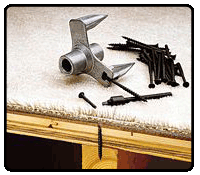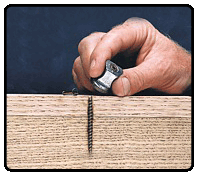Should I be concerned about serious health risks from mould?
It is important to note that everyone is exposed to mould spores on a daily basis. Mould grows naturally in our outdoor environment. Even though mould spores are found in our homes and buildings we do not want them growing there. Mould is known to be an allergen and some cases toxic. There are very few reports of toxic moulds inside homes causing rare health conditions. A better safe than sorry approach should be taken. Any mould contamination existing inside buildings and homes should be eradicated. The Mayo tests found that over ninety-three percent of cases of chronic bronchitis were the result of fungal infection, not bacteria as is generally assumed. (Taken from Dr. Michael Pinto’s book Fungal Contamination, A Comprehensive Guide for Remediation) Individuals with immune or respiratory problems, pregnant-women, the elderly, and children may be at increased risk of illness from moulds.
What are the health effects of mould?
.Health effects of mould are dependent upon the individual, length of exposure, and volume of spores inhaled or ingested. Some effects include, but are not limited to:
Chronic headaches,
Eyes, nose and throat irritation,
Sneezing,
Coughing,
Nausea,
Fever,
Vomiting,
Diarrhea,
Chronic fatigue,
Asthma/respiratory problems.
How common is mould in buildings?
Mould is very common in our homes and buildings. The most common mould in our homes is mould found on bread. All moulds are not harmful. But infestations of mould need to be controlled immediately upon discovery.
How do moulds get inside and how do they grow?
Mould spores may enter your home through open doorways, windows, heating, ventilation, and air conditioning systems. Spores may also attach themselves to people, animals, toys, shoes, and carry bags bringing the mould indoors.
Many building materials provide nutrients that allow the mould to cultivate when exposed to moisture. Wet materials, including paper products, cardboard, ceiling tiles, and wood products, are primary sites for mould growth. Other materials such as dust, paints, wallpaper, insulation materials, drywall, carpet, and upholstery, also support the growth of mould.
What is Stachybotrys?
Stachybotrys is a specific kind of mould present in our environment. Outdoor Stachybotrys moulds help decay organic matter. One particular species known as Stachybotrys atra (sometimes known as Stachybotrys chartarum) is prone to growth indoors. This mould is normally dark brown or black in colour. It can look slimy, sooty, or even like grayish white strands, depending on the amount of moisture available and the length of time it has been growing. Many other common indoor moulds can look similar to Stachybotrys.
It is important to remember no matter what type of mould you have removal is the only course of action.
How do I know if I have a mould problem?
A visual examination is the most dependable means of identifying a mould problem. Musty odours or changes in health could be the first signs of mould in your home. Some signs to look for would be standing water, condensation on windows, floods, or roof leaks - all of which could lead to mould growth. Mould may grow in your wall cavities or attic spaces where it is not easily found. When unsure, call in a professional.
What should people do if they determine they have mould?
First thing to do if you have mould is determine the extent of the problem. This might, and most times should, be done in conjunction with a professional. This might require a consultation only, but remember health is the most important part of the clean-up process. A professional will be able to guide you in the right direction.
Underlying problems that have allowed the mould to grow will become part of the process to clean and rid your home of further unwanted mould growth.
How do you keep mould out of buildings and homes?
Buildings should be inspected on a regular basis for evidence of water damage. Conditions such as water leaks, flooding, condensation or excessive humidity should be corrected immediately upon discovery to prevent mould from growing.
Recommendations:
Be sure the building is properly ventilated
Clean bathrooms on a regular basis
Wipe up spills immediately
Remove or dry out flood damaged building materials within 24 to 48hrs
Can I make my landlord test my apartment for mould?
No. If you believe you have a mould problem, you will need to take pictures and document your problem, or contact us for an inspection by one of our certified mould inspectors. You may need to take the information gathered to the Rental Tribunal or your local building standards by-law office for help remediating your situation.
Should I paint over mould?
No. Mould is an allergen and must be removed to rid the home or building of its effects.
Common Myths about Mould
My house is mould-free...
Mould grows naturally in our outdoor environment. Even though mould spores are found in our homes and buildings we do not want them growing there. Mould is known to be an allergen and some cases toxic. There are very few reports of toxic mould inside homes causing rare health conditions. A better safe than sorry approach should be taken. Any mould contamination existing inside buildings and homes should be removed. The Mayo tests established that over ninety-three percent of cases of chronic bronchitis were the result of fungal infection, not bacteria as is generally assumed. (Taken from Dr. Michael Pinto’s book Fungal Contamination, A Comprehensive Guide for Remediation) Individuals with immune or respiratory problems, pregnant women, the elderly, and children may be at increased risk of illness from moulds.
Dead mould won’t hurt me...
Dead mould can be as harmful as live mould. Dead or alive, mould spores are still allergens.
If I can’t see mould, I don’t have mould...
Mould is part of nature. Every home and work place has mould. If you are concerned that mould is a problem in your home and you can’t see it, it may be necessary to have a qualified inspector investigate your concern. There may be hidden areas where mould could be growing. Common areas of concern are behind basement wall finishes or attics.
Toxic black Mould...
What does it mean if you have black toxic mould? The first thing to consider is how do you know it’s toxic? All black mould is not toxic and all toxic mould is not black.
Black is just a colour. Many moulds appear black in colour. In fact, mould comes in many colours - every colour in the rainbow. Black mould (as referred to by the media) is Stachybotrys Chartarum. Stachybotrys has the ability to produce mycotoxins.
Regardless of the type, mould should be removed as people can react differently to different types of mould. What might bother one person may not bother another. Mould removal is the best course of action.
If I paint over mould no one will ever know it was there...
Painting over mould just covers it up. When this mould comes in contact with moisture it will begin to grow. The best practice is to remove visible signs of mould before treating the surface with any chemical or paint.
My house is clean, I don’t have mould...
Even the cleanest homes have mould. Mould is a part of nature. The job mould has in life is to break down organic material and return it to nature. Having mould is a moisture issue - not a cleanliness issue.
I live in a new build, I don’t have mould...
The age of a home or building has no relationship to mould. Moisture is the key to controlling mould. Mould will not grow in a dry home.


 Dug Wells
Dug Wells  Drilled Wells
Drilled Wells 



